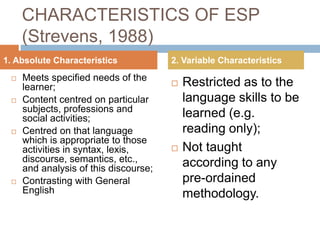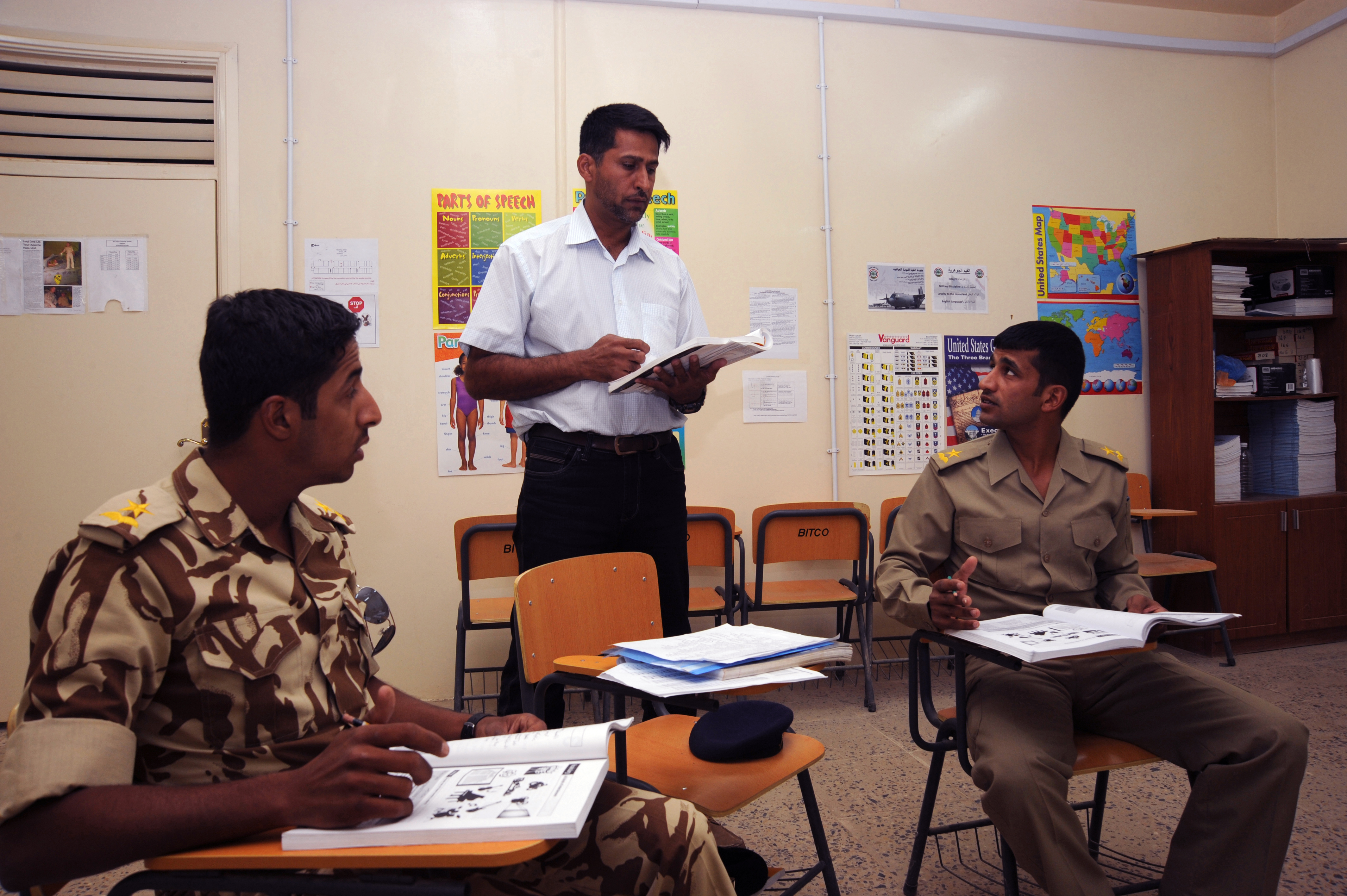Notions and Development of English for Specific Purposes
Aperçu des sections
-
-
Forum
-
This section contains all the necessary information for students to start the course on the right foot. The shared course description acts as a verbal contract between the teacher and the students for a successful course with encouraging teaching/learning outcomes.
-
Page
Students will find the contents of the whole course, for both semesters of the 2022-2023 academic year, shared here

-
-
-
Leçon
This lesson describes the emergence and development of
Language for Specific Purposes (LSP) in general and ESP in particular.
Evolution
ESP or English for Specific Purposes is a flourishing field of study and research in
applied linguistics and Teaching English as a Foreign Language. It has been developing
steadily since the 1960s. The main reasons behind the emergence and development of ESP
and specialized classes are related to the following:
- The demands of a brave new world
- Revolution in linguistics
- New focus on the learner.
Activity: Pair work- Discuss the reasons behind the creation of specialized classes.
What Hutchinson and Waters (1987) stated elaborates the idea of the need for more
specialized classes. They believe that “…, it created a new generation of learners who knew
specifically why they were learning a language…” (p. 6)
With this new perspective in teaching English as Foreign Language, it became
apparent that discourses vary according to the contexts. It was, accordingly, necessary to
reorganize the teaching and learning methodologies and make the specific features of each
situation the basis of the learner’s courses. Thus, the terminology, method, and techniques will vary.
-
Page
This is a summary of the first lesson.

Tell me what you need English
for and I will tell you the English
you need.An elaboration of the effect of the Second World War on Teaching English as a Foreign
Language and what is meant by the changing world order.
- The outcomes of the second world war.
Political and social change.
- Economic development.
- The new status of English as a lingua franca.
- Linking war outcomes to the language.
- Linking learning English and fast economic development.
- The increasing need for specialized language courses.
Evolution in ESP is stated through different definitions discussed later. The ESP course
has become more learner-centred.
-
Devoir
This task is designed to assess students' understanding of the development and the necessity of ESP.
In your opinion, which of the three reasons affected the development of ESP more?
-
-
-
Different definitions of ESP, why?
ESP

Defining ESP
Some people described ESP as simply being the teaching of English for any purpose that could be specified. Others, however, were more precise describing it as the teaching of English used in academic studies or the teaching of English for vocational or professional purposes. Anthony (1997, p. 9-10).
“ESP is generally used to refer to the teaching of English for a clearly utilitarian purpose.” Mackay and Mountford (1978, p. 2).
Generally, the Students study English “not because they are interested in the English Language or English culture as such, but because they need English for study or work purposes” (Robinson, 1991, p. 2).In ESP, “language is learnt not for its own sake or for the sake of gaining a general education, but to smooth the path to entry or greater linguistic efficiency in academic, professional or workplace environments” Basturkmen (2006, p. 18).
-
-
-
Leçon
This lesson focuses on the main differences between ESP and EGP courses
-
This assignment examines students' reasoning and understanding of differences between ESP and EGP classes
-
Difference between ESP and EGP courses. Click on the link above (ASPECTS OF DIFFERENCE) to view a detailed table elaborating on the main differences between ESP and EGP.
-
-
-
There are two main characteristics of ESP: Absolute and Variable characteristics. Click on the link above for more details!

Characteristics
Characteristics of ESP
ESP is a recognizable activity of English Language Teaching (ELT) with some specific characteristics. Dudley-Evans and St. John (1998) tried to apply a series of characteristics, some absolute and some variable, to outline the major features of ESP.
Absolute Characteristics:
1. ESP is defined to meet specific needs of the learners;
2. ESP makes use of underlying methodology and activities of the discipline it serves;
3. ESP is centred on the language (grammar, lexis, register), skills, discourse and
genre appropriate to these activities.
Variable Characteristics:
1. ESP may be related to or designed for specific disciplines;
2. ESP may use, in specific teaching situations, a different methodology from that of
General English; CONTENT BASED AND PROJECT BASED LEARNING
THERE IS NO PERFECT/BEST TEACHING METHOD – IT DEPENDS ON THE LEARNER THE NEEDS AND THE TARGET SITUATION
3. ESP is likely to be designed for adult learners, either at a tertiary-level institution or in a professional work situation. It could, however, be for learners at the secondary school level;
4. ESP is generally designed for intermediate or advanced students. Most ESP courses
assume some basic knowledge of the language systems, but they can be used with beginners. (Dudley-Evans and St. John, 1998, p. 4)
Hutchinson and waters (1987, p. 19) state "ESP should properly be seen not as any particular language product but as an approach to language teaching in which all decisions as to content and method are based on the learner's reason for learning".
-
-
-
Leçon
Click on the link above (Types of ESP) for the full lesson

-
Test
Activity: choose a field of your own and decide which courses are to be designed for occupational and academic purposes and speculate some language aspects to teach and an objective to be reached.

-
The video shows different branches of ESP with some examples.
Watch the video and take note of the information you do not understand.
link: https://www.youtube.com/watch?v=g-uCH-PxRyw&ab_channel=UNIV-ENGLISH
-
-
-
Even if teaching ESP courses seems to be for very specific linguistic needs, it is still a bit more than that. Click on the link above to find out more about why we teach ESP and about the objectives' logic.
-
This forum is open to students to interact and clarify ambiguities concerning the objectives of teaching ESP
-
Devoir
-
-
-
Teaching and learning in ESP
-
Page
Who is the ESP teacher?
Click on the link above for more details!
Example: English for Aviation Purposes (Military) in Iraq
-
Page
What makes the ESP learner special?
Check out the details following the link above

-
-
-
This is what makes the teaching process in ESP unique!
Click the link above to find out!
-
Look closely at this diagram.
In a short paragraph, explain what you have understood from this circle.
-
-
-
Stages of ESP Course Design between Theory and Reality (Dudley-Evans and Johns 1998, p. 121)

-
This is a similar process (conducted in Algeria) of the theoretical framework of ESP course design
Professor Miliani (1994) of the University of Oran explains designing an effective ESP course taking into account the Algerian context:
a- Situation analysis: it envelopes the general requirements of both learners and institutions, their profiles and attitudes, also the existing materials.
b- Setting Aims and Objectives: the results of learners’ needs identification and analysis (NIA) lead to setting up general statements and what would be achieved at the end of the courses.
c- Generating Syllabus Content: organizing the syllabus content “through the sequencing of materials whose layout and presentation should form a continuum”. (Benyelles, 2009, p. 58).
d- Assessment: gathering data regarding syllabus before or during the course implementation let to readjust the content of the syllabus.
-
Teaching ESP in a Nutshell

-
-
-
This video summarizes the main points discussed in this semestrial section of the course.
https://www.youtube.com/watch?v=3eCj7iulp4A&t=2s&ab_channel=soooo
-
Devoir
After watching the video, take note of the information you did not understand.
In a brief paragraph, mention what you have learned during this first semester that was not mentioned in the video, or vice-versa.
-
-
-

